Grain Refinement of Inconel 718 Superalloy—The Effect of Rotating Magnetic Field
Abstract
:1. Introduction
- Variation of casting parameters (namely by controlling the casting temperature and the heat transfer at the interface metal/mould);
- Addition of grain refinement agents (Inoculants, e.g., CoAl2O4);
- Mechanical vibration.
2. Materials and Experimental Procedure
2.1. Materials
2.2. Investment Casting Process
- Pre-heating of the ceramic shells (T = 1000 °C), crucible and inconel’s ingot (T = 250 °C);
- Placement of the shell, crucible and metallic ingot in the casting equipment;
- Vacuum application inside the casting chamber (pressure: 0.1 mbar);
- Inconel’s ingot melting initiation;
- Pouring of the metal into the ceramic shell (by gravity effect);
- EMS application (duration: 15 min);
- Air cooling of the ceramic shell.
2.3. Casting’s Characterization
3. Experimental Results and Discussion
3.1. Grain Size Evaluation
3.2. Microstructures and Metallographic Evaluation
3.3. Mechanical Properties
4. Conclusions
- The application of rotating magnetic field subsequent to the pouring of IN718 significantly contributed to the reduction of the average grain size of the castings. Therefore, the results accomplished demonstrate that the forced liquid metal movement during casting’s solidification caused by the RMF effectively generates grain refinement.
- An average grain area decrease greater than 96% was achieved in the castings where RMF frequencies of 75 Hz and 150 Hz were applied. The greatest reduction (96.82%) was attained in the peripheral section of casting no. 3 (RMF frequency: 75 Hz), which represents a grain area decrease from 94.64 mm2 to 3.01 mm2.
- The application of RMF caused a morphological change in the cast parts: at casting no. 1, produced without application of RMF, dendrites with cellular morphology are predominant; in the remaining three castings, submitted to RMF, dendrites’ morphology is mainly equiaxed.
- Regarding the microstructural evaluation, similar phase composition and distribution within the dendritic and interdendritic areas were visualized in the four castings produced. The major dissimilarity perceived in the samples submitted to RMF was the evident decrease in size and quantity of the needle-like δ phase (orthorhombic Ni3Nb). Additionally, in these samples, the precipitation of the γ’’ smaller plate-like phases seems to be pronounced.
- Concerning the mechanical properties of the cast parts, no major differences were observed in the tensile testing and macro hardness measurements performed in the specimens of the castings submitted, or not, to rotating magnetic field. Therefore, the application of RMF during the beginning of the castings’ solidification appears not to have significantly affected their mechanical properties.
- Since the application of rotating magnetic field vastly contributed to the reduction of the average grain size of the cast parts and caused the reduction of the needle-like δ phase, which is responsible for the decrease of strength and ductility of IN718, it was expected that the mechanical properties of the castings would increase due to RMF. However, as pointed out in the previous paragraph, that was not verified in the tensile testing results. This effect might be related to the great size of the castings, which contributes for the generation of shrinkage porosities in its center, the section from where tensile testing specimens were extracted. The presence of these defects negatively affected the mechanical properties of the specimens, preventing one from differentiating between the results from the samples with and without application.
- Due to the great size of the cast parts, most of the samples produced presented shrinkage porosities. Casting no. 4 (RMF frequency 150 Hz) was the one with the greatest number of these casting defects, mainly in its central section. According to the state-of-art, these casting defects could be minimized with the execution of a HIP treatment, where the IN718 cast parts would be hot isostatically pressed in order to reduce the porosities generated due to alloy contractions.
Author Contributions
Funding
Institutional Review Board Statement
Informed Consent Statement
Data Availability Statement
Acknowledgments
Conflicts of Interest
References
- Jia, Q.B.; Gu, D.D. Selective laser melting additive manufacturing of Inconel 718 superalloy parts: Densification, microstructure and properties. J. Alloy. Compd. 2014, 585, 713–721. [Google Scholar] [CrossRef]
- Lee, H.T.; Hou, W.H. Fine Grains Forming Process, Mechanism of Fine Grain Formation and Properties of Superalloy 718. Mater. Trans. 2012, 53, 716–723. [Google Scholar] [CrossRef] [Green Version]
- Caliari, F.R.; Guimaraes, N.M.; Reis, D.A.P.; Couto, A.A.; Neto, C.D.; Candioto, K.C.G. Study of the Secondary Phases in Inconel 718 Aged Superalloy Using Thermodynamics Modeling. Key Eng. Mater. 2013, 553, 23–28. [Google Scholar] [CrossRef]
- Kang, M.; Wang, J.; Gao, H.; Han, Y.; Wang, G.; He, S. Effect of Solidification Behavior on Microstructures and Mechanical Properties of Ni-Cr-Fe Superalloy Investment Casting. Materials 2017, 10, 250. [Google Scholar] [CrossRef] [PubMed] [Green Version]
- El-Bagoury, N.; Matsuba, T.; Yamamoto, K.; Miyahara, H.; Ogi, K. Influence of heat treatment on the distribution of Ni2Nb and microsegregation in cast Inconel 718 alloy. Mater. Trans. 2005, 46, 2478–2483. [Google Scholar] [CrossRef] [Green Version]
- Ling, L.-S.-B.; Yin, Z.; Hu, Z.; Liang, J.-H.; Wang, Z.-Y.; Wang, J.; Sun, B.-D. Effects of the γ″-Ni3Nb Phase on Mechanical Properties of Inconel 718 Superalloys with Different Heat Treatments. Materials 2020, 13, 151. [Google Scholar] [CrossRef] [Green Version]
- Soffel, F.; Eisenbarth, D.; Hosseini, E.; Wegener, K. Interface strength and mechanical properties of Inconel 718 processed sequentially by casting, milling, and direct metal deposition. J. Mater. Process. Technol. 2021, 291, 117021. [Google Scholar] [CrossRef]
- Jin, W.Z.; Bai, F.D.; Li, T.J.; Yin, G.M. Grain refinement of superalloy IN100 under the action of rotary magnetic, fields and inoculants. Mater. Lett. 2008, 62, 1585–1588. [Google Scholar] [CrossRef]
- Lyu, F.; Liu, F.; Hu, X.; Yang, X.; Huang, C.; Shi, D. The δ Phase Precipitation of an Inconel 718 Superalloy Fabricated by Electromagnetic Stirring Assisted Laser Solid Forming. Materials 2019, 12, 2604. [Google Scholar] [CrossRef] [Green Version]
- Zhang, D.Y.; Feng, Z.; Wang, C.J.; Wang, W.D.; Liu, Z.; Niu, W. Comparison of microstructures and mechanical properties of Inconel 718 alloy processed by selective laser melting and casting. Mater. Sci. Eng. A 2018, 724, 357–367. [Google Scholar] [CrossRef]
- Zhang, D.Y.; Niu, W.; Cao, X.Y.; Liu, Z. Effect of standard heat treatment on the microstructure and mechanical properties of selective laser melting manufactured Inconel 718 superalloy. Mater. Sci. Eng. A 2015, 644, 32–40. [Google Scholar] [CrossRef]
- Zhao, Y.H.; Li, K.; Gargani, M.; Xiong, W. A comparative analysis of Inconel 718 made by additive manufacturing and suction casting: Microstructure evolution in homogenization. Addit. Manuf. 2020, 36, 101404. [Google Scholar] [CrossRef]
- Carlson, R.G.; Radavich, J.F. Microstructural characterization of cast 718. In Superalloy 718—Metallurgy and Applications; The Minerals, Metals, and Materials Society: Pittsburgh, PA, USA, 1989; pp. 79–95. [Google Scholar]
- Pereira, J.C.; Aranzabe, J.; Taboada, M.C.; Ruiz, N.; Rodriguez, P.P. Analysis of Microstructure and Mechanical Properties in As-Built/As-Cast and Heat-Treated Conditions for IN718 Alloy Obtained by Selective Laser Melting and Investment Casting Processes. Crystals 2021, 11, 1196. [Google Scholar] [CrossRef]
- Lin, Y.C.; Deng, J.; Jiang, Y.-Q.; Wen, D.-X.; Liu, G. Effects of initial δ phase on hot tensile deformation behaviors and fracture characteristics of a typical Ni-based superalloy. Mater. Sci. Eng. A 2014, 598, 251–262. [Google Scholar] [CrossRef]
- Liu, F.; Lyu, F.; Liu, F.; Lin, X.; Huang, C. Laves phase control of inconel 718 superalloy fabricated by laser direct energy deposition via δ aging and solution treatment. J. Mater. Res. Technol. 2020, 9, 9753–9765. [Google Scholar] [CrossRef]
- Liu, L.; Zhang, R.; Wang, L.D.; Pang, S.X.; Zhen, B.L. A new method of fine grained casting for nickle-base superalloys. J. Mater. Process. Technol. 1998, 77, 300–304. [Google Scholar] [CrossRef]
- Chang, S.-H. In situ TEM observation of γ′, γ″ and δ precipitations on Inconel 718 superalloy through HIP treatment. J. Alloy. Compd. 2009, 486, 716–721. [Google Scholar] [CrossRef]
- Nawrocki, J.; Motyka, M.; Szeliga, D.; Ziaja, W.; Cygan, R.; Sieniawski, J. Effect of cooling rate on macro- and microstructure of thin-walled nickel superalloy precision castings. J. Manuf. Processes 2020, 49, 153–161. [Google Scholar] [CrossRef]
- Szajnar, J.; Stawarz, M.; Wróbel, T.; Sebzda, W. Influence of electromagnetic field on pure metals and alloys structure. J. Achiev. Mater. Manuf. Eng. 2009, 34, 95–102. [Google Scholar]
- Wang, F.; Wang, E.G.; Zhang, L.T.; Jia, P.; Wang, T. Influence of electromagnetic stirring (EMS) on the microstructure and mechanical property of Incoloy825 superalloy. J. Manuf. Processes 2017, 26, 364–371. [Google Scholar] [CrossRef]
- Liu, F.C.; Cheng, H.M.; Yu, X.B.; Yang, G.; Huang, C.P.; Lin, X.; Chen, J. Control of microstructure and mechanical properties of laser solid formed Inconel 718 superalloy by electromagnetic stirring. Opt. Laser Technol. 2018, 99, 342–350. [Google Scholar] [CrossRef]
- Rakoczy, L.; Grudzien, M.; Cygan, R.; Zielinska-Lipiec, A. Effect of Cobalt Aluminate Content and Pouring Temperature on Macrostructure, Tensile Strength and Creep Rupture of Inconel 713c Castings. Arch. Metall. Mater. 2018, 63, 1537–1545. [Google Scholar] [CrossRef]
- Singh, S.; Andersson, J. Hot cracking in cast alloy 718. Sci. Technol. Weld. Join. 2018, 23, 568–574. [Google Scholar] [CrossRef]

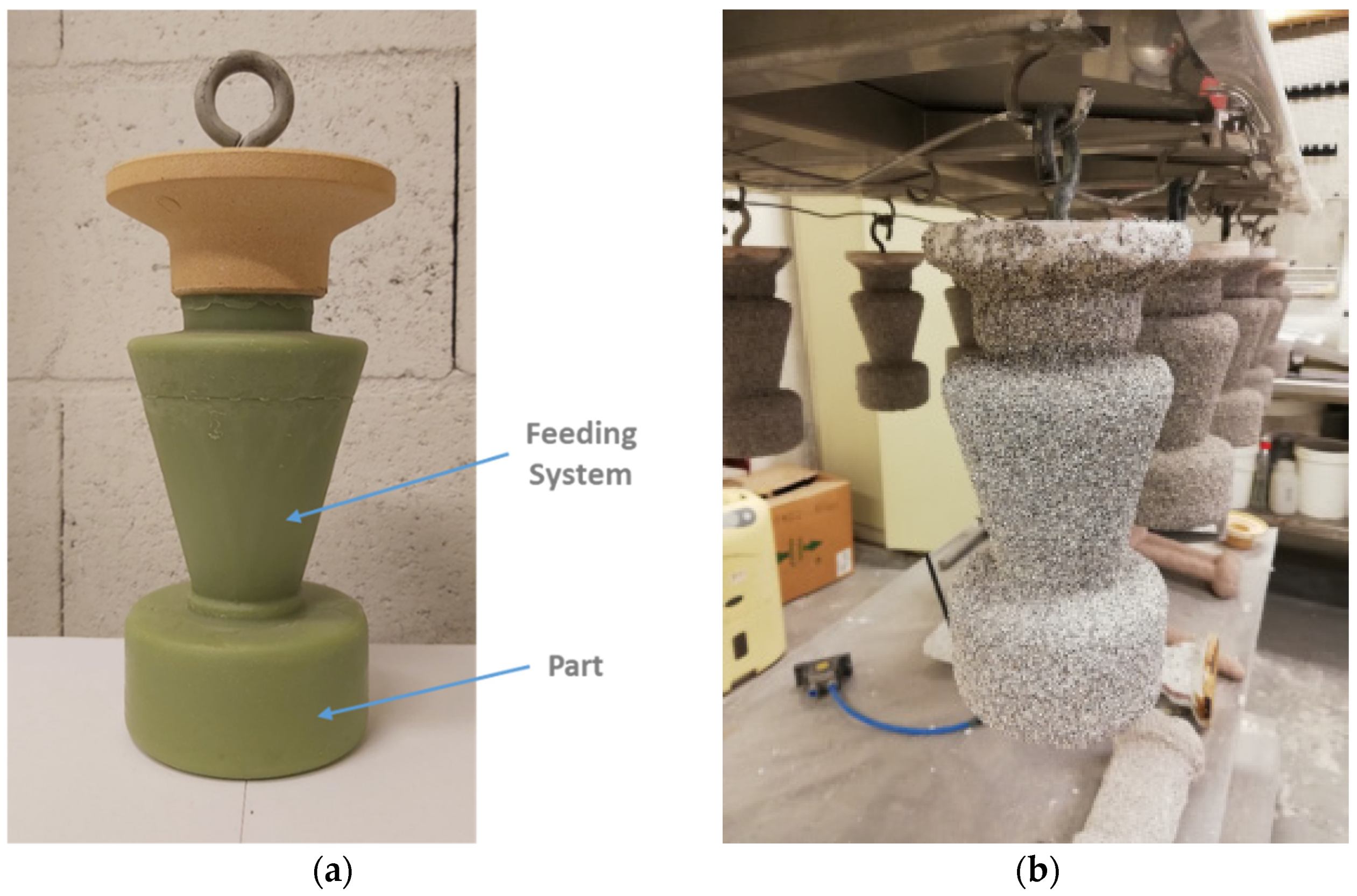


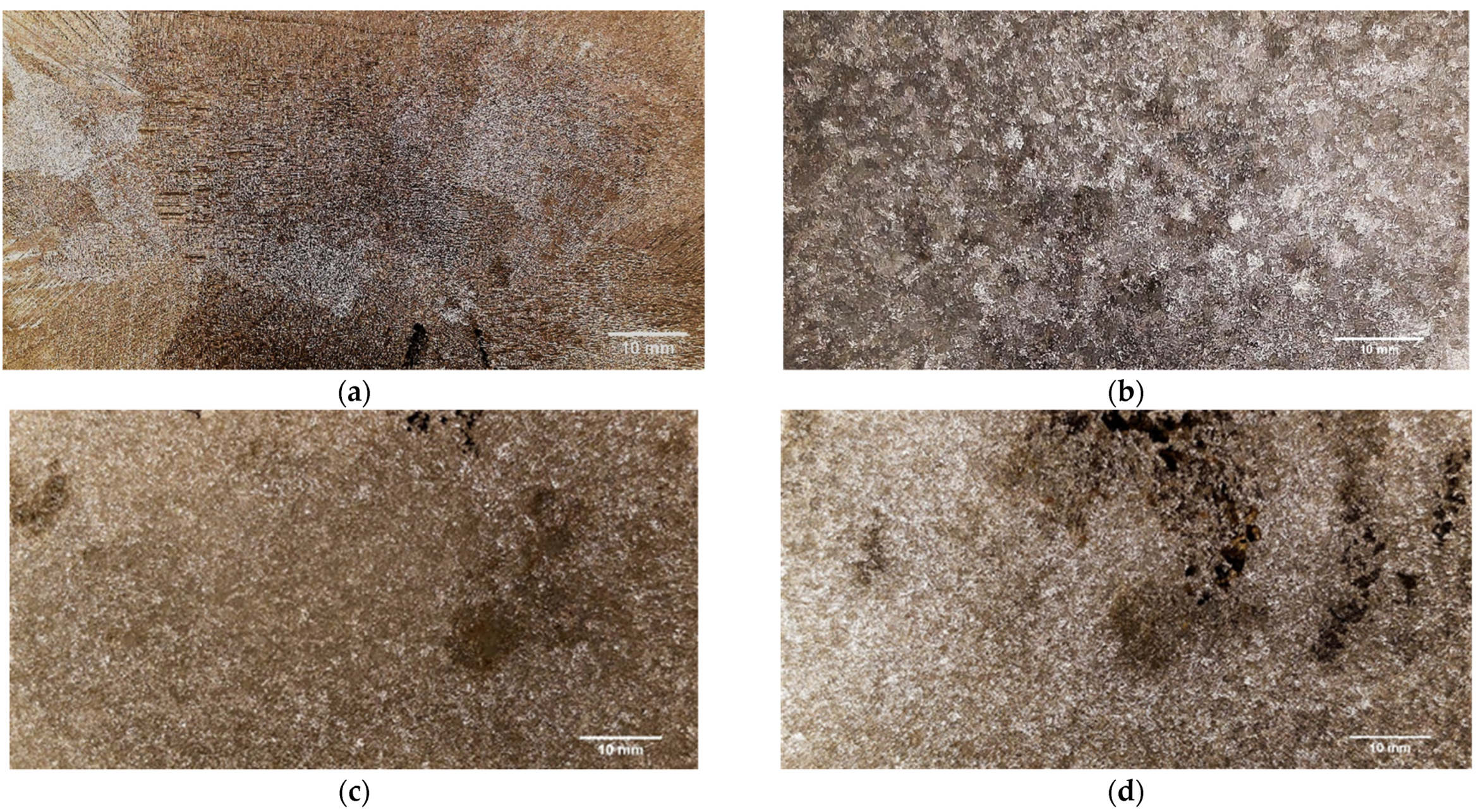
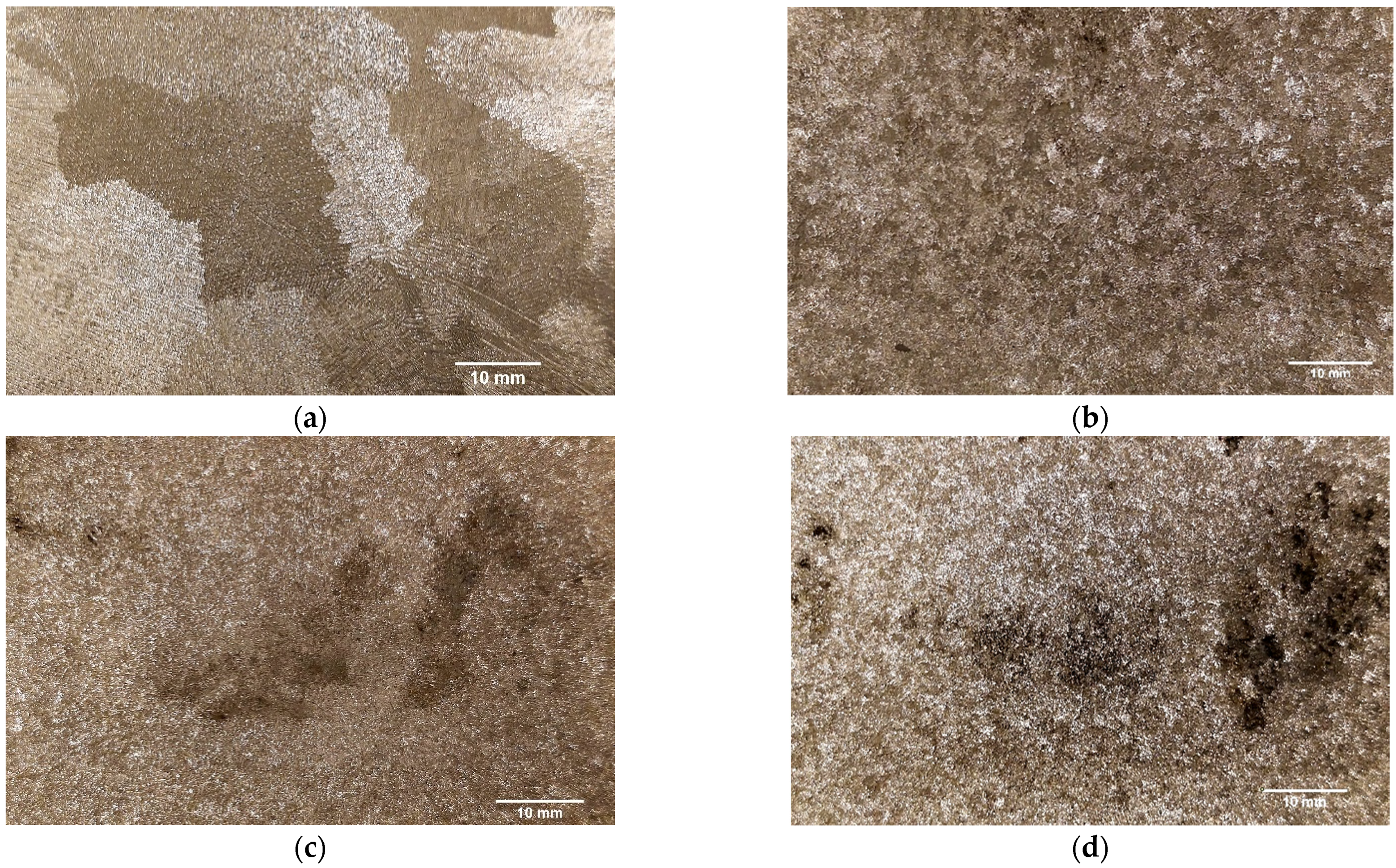

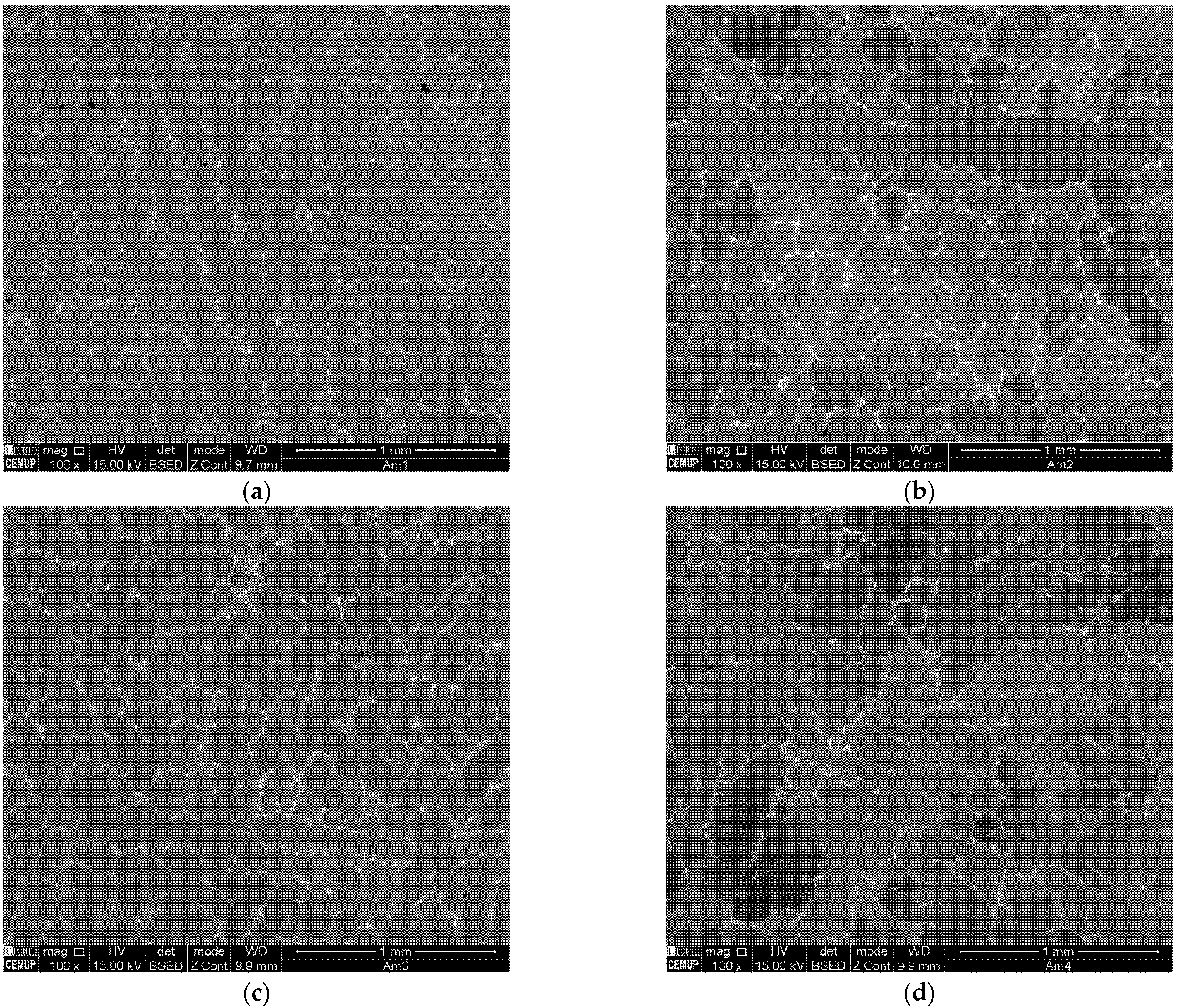
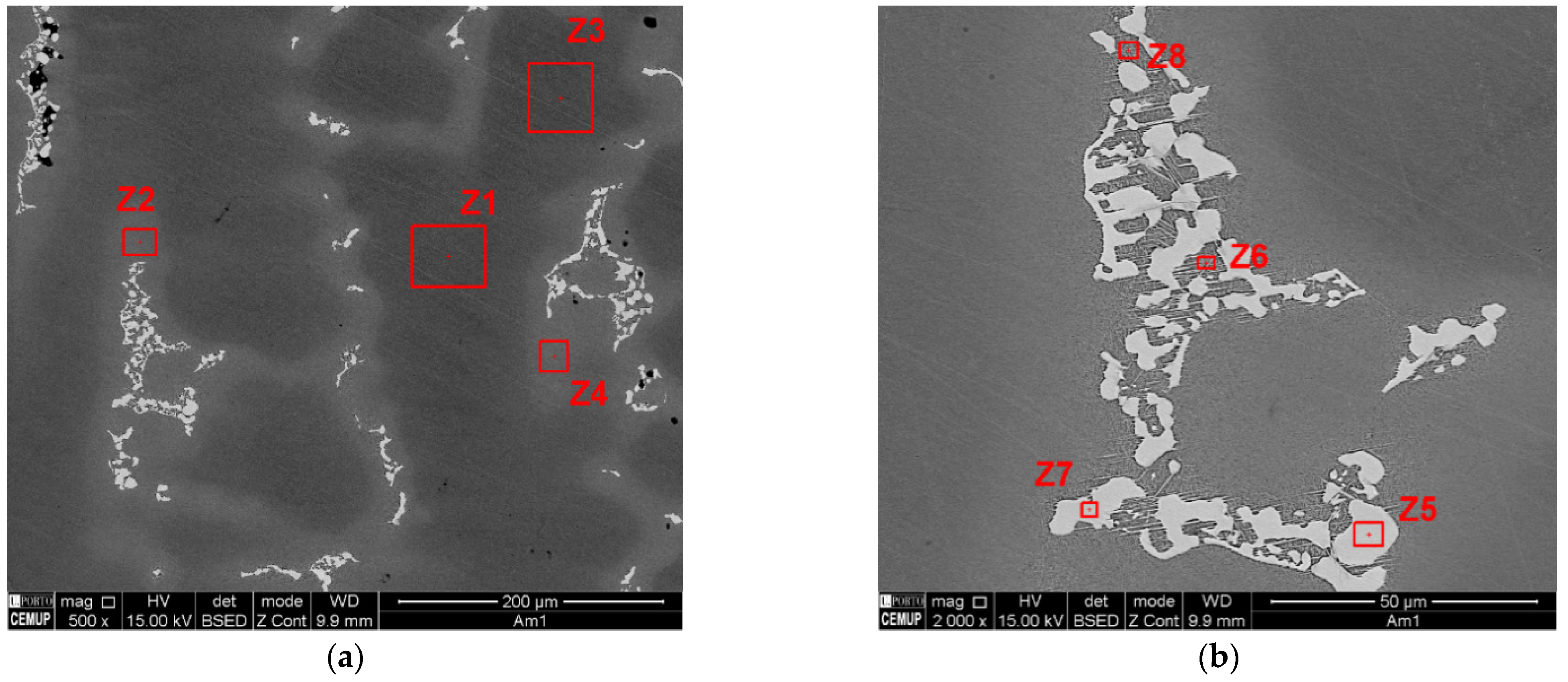

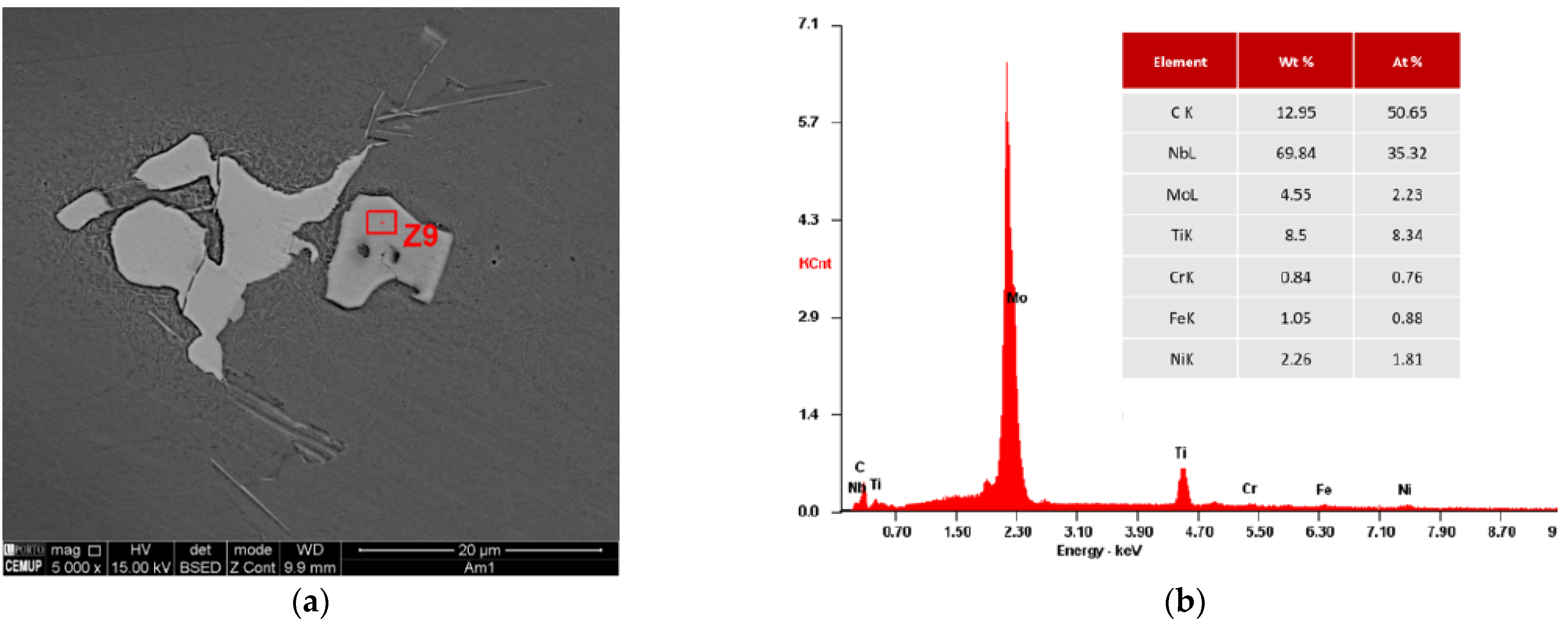
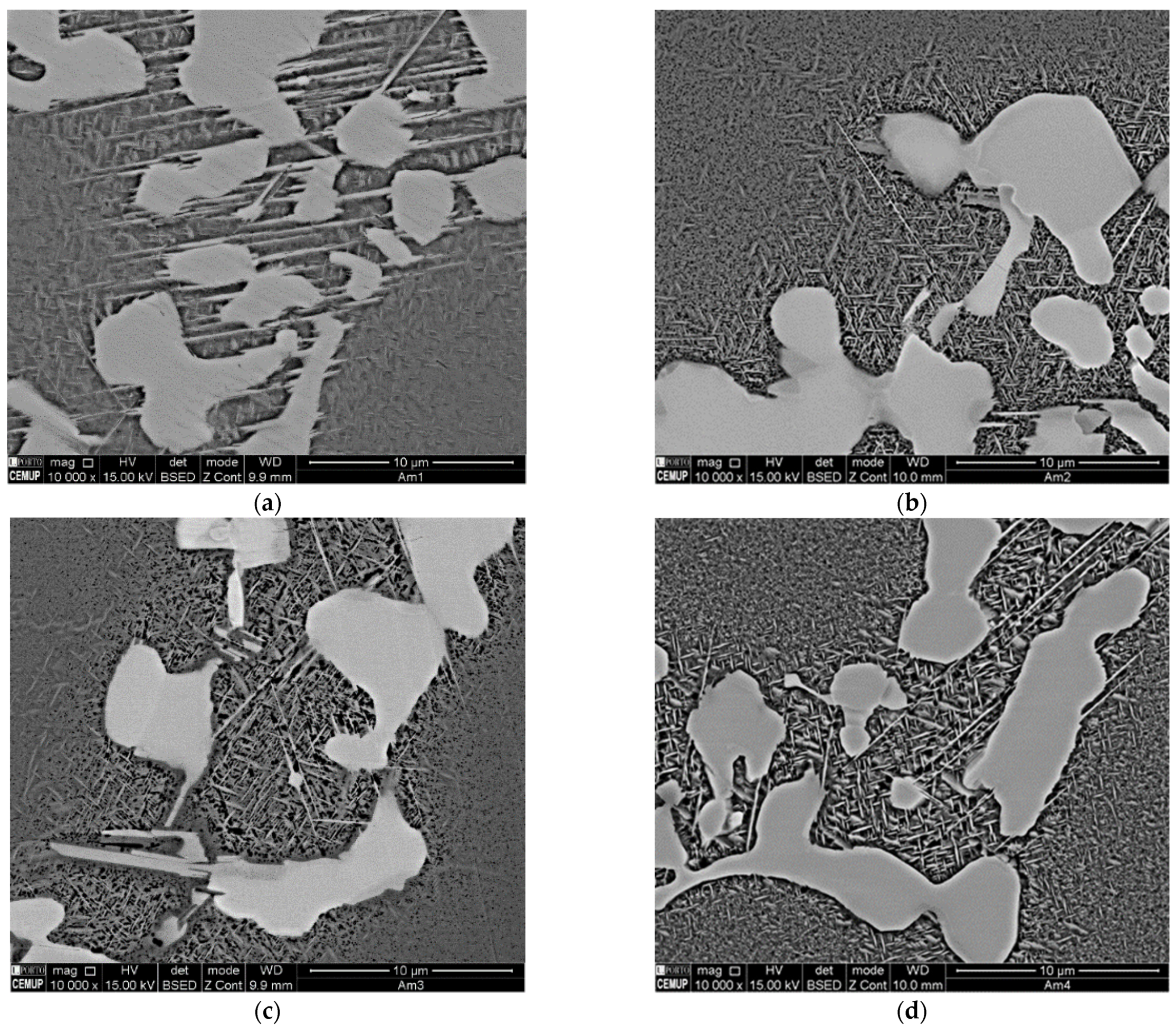
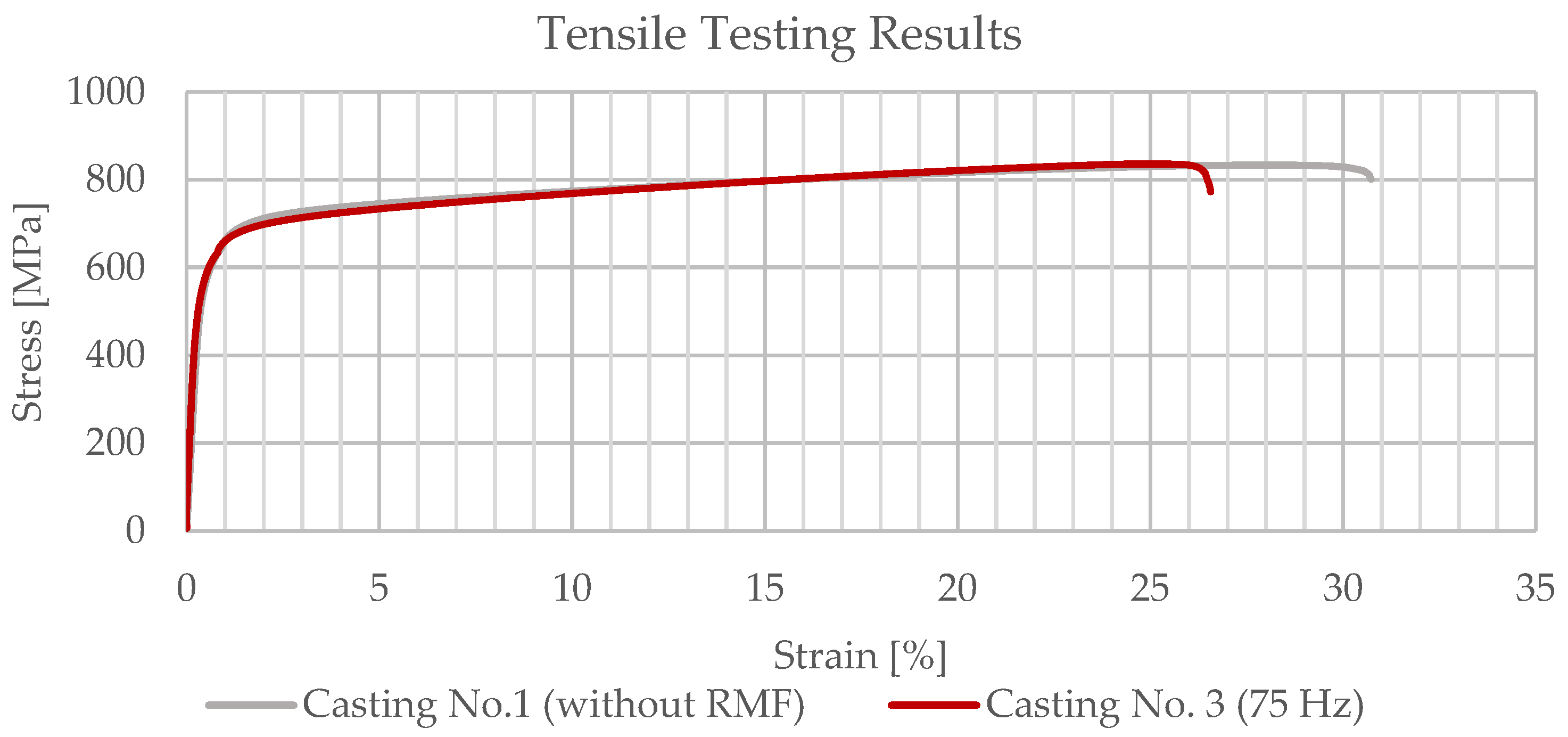
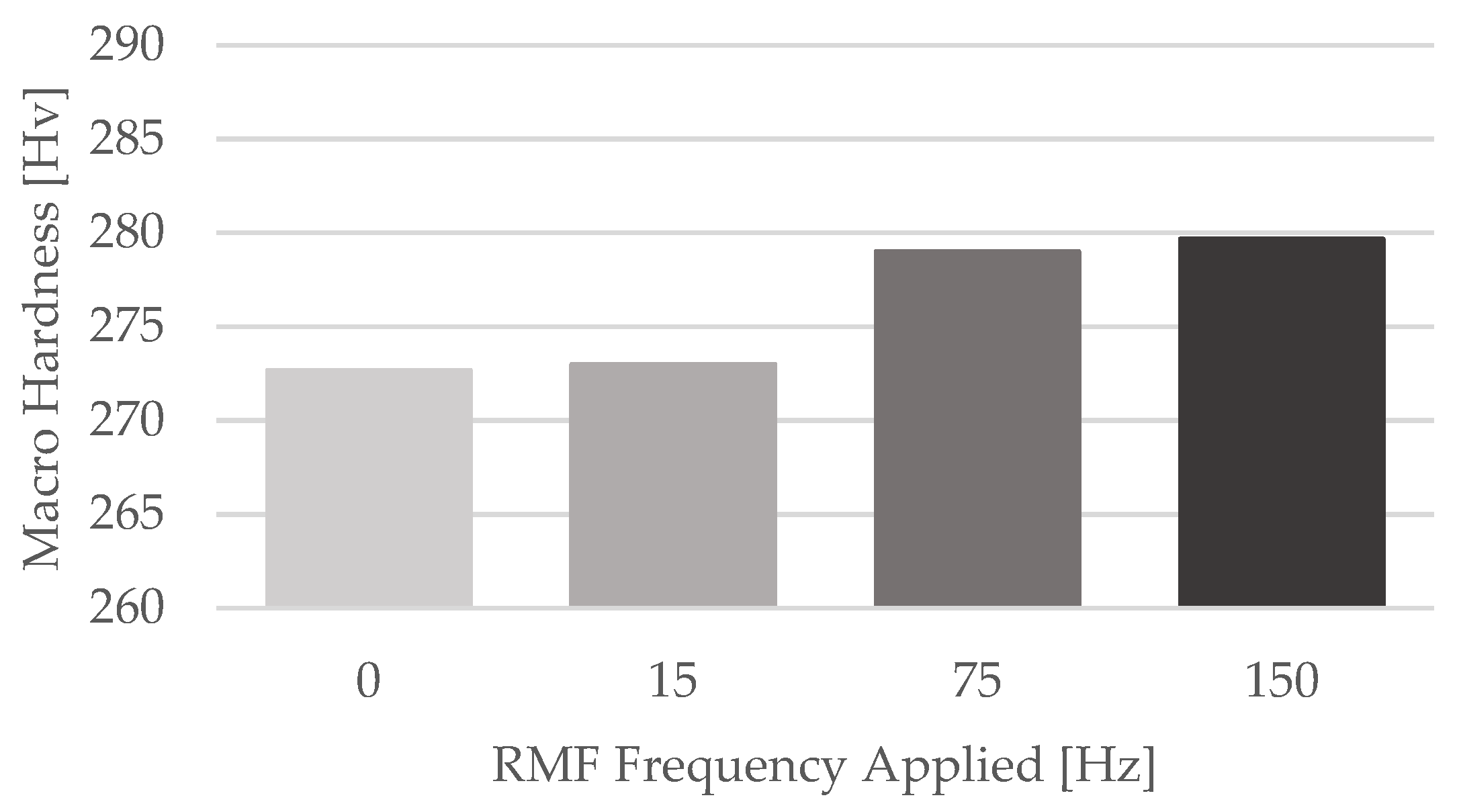
| Element | C | Mn | Si | Ti | Cu | Al | Co | Mo | Nb | Fe | Cr | Ni |
|---|---|---|---|---|---|---|---|---|---|---|---|---|
| Standard composition (%) | ≤0.08 | ≤0.35 | ≤0.35 | 0.65–1.15 | ≤0.30 | 0.20–0.80 | ≤1.0 | 2.80–3.30 | 4.75–5.50 | Bal | 17.00–21.00 | 50.00–55.00 |
| Actual composition (%) | 0.032 | 0.015 | 0.073 | 0.871 | 0.0093 | 0.65 | 0.045 | 3.01 | 5.36 | 19.59 | 18.09 | 52.00 |
| Casting Number | Frequency (Hz) | RMF Current Intensity (A) | RMF Treatment Time (s) | Power (kW) |
|---|---|---|---|---|
| 1 | 0 * | - | - | - |
| 2 | 15 | 80 | 900 | 65 |
| 3 | 75 | 80 | 900 | 65 |
| 4 | 150 | 80 | 900 | 65 |
| Casting Number | RMF Frequency (Hz) | Section | Test Line No. | Ni | (mm) | (mm) | ASTM Macro Grain Size-G | |
|---|---|---|---|---|---|---|---|---|
| 1 | without magnetic field | Center | 1 | 5 | 0.125 | 8.00 | 8.00 | M-4.00 |
| 2 | 5 | 0.125 | 8.00 | |||||
| 3 | 5 | 0.125 | 8.00 | |||||
| Periphery | 1 | 4 | 0.100 | 10.0 | 8.667 | M-3.77 | ||
| 2 | 5 | 0.125 | 8.00 | |||||
| 3 | 5 | 0.125 | 8.00 | |||||
| 2 | 15 | Center | 1 | 23 | 0.575 | 1.74 | 1.771 | M-8.35 |
| 2 | 24 | 0.600 | 1.67 | |||||
| 3 | 21 | 0.525 | 1.91 | |||||
| Periphery | 1 | 19 | 0.475 | 2.11 | 2.183 | M-7.75 | ||
| 2 | 18 | 0.450 | 2.22 | |||||
| 3 | 18 | 0.450 | 2.22 | |||||
| 3 | 75 | Center | 1 | 26 | 0.650 | 1.54 | 1.465 | M-8.90 |
| 2 | 28 | 0.700 | 1.43 | |||||
| 3 | 28 | 0.700 | 1.43 | |||||
| Periphery | 1 | 24 | 0.600 | 1.67 | 1.545 | M-8.75 | ||
| 2 | 26 | 0.650 | 1.54 | |||||
| 3 | 28 | 0.700 | 1.43 | |||||
| 4 | 150 | Center | 1 | 28 | 0.700 | 1.43 | 1.454 | M-8.92 |
| 2 | 30 | 0.750 | 1.33 | |||||
| 3 | 25 | 0.625 | 1.60 | |||||
| Periphery | 1 | 25 | 0.625 | 1.60 | 1.702 | M-8.47 | ||
| 2 | 25 | 0.625 | 1.60 | |||||
| 3 | 21 | 0.525 | 1.91 |
| Casting No. | RMF Frequency (Hz) | Section | (No./mm2) | (mm2) | Grain Size Reduction * (%) |
|---|---|---|---|---|---|
| 1 | without magnetic field | Center | 0.0124 | 80.64 | - |
| Periphery | 0.0106 | 94.64 | - | ||
| 2 | 15 | Center | 0.2533 | 3.95 | 95.10 |
| Periphery | 0.1665 | 6.01 | 93.65 | ||
| 3 | 75 | Center | 0.3697 | 2.70 | 96.65 |
| Periphery | 0.3327 | 3.01 | 96.82 | ||
| 4 | 150 | Center | 0.3754 | 2.66 | 96.70 |
| Periphery | 0.2741 | 3.65 | 96.14 |
| Casting No. | Frequency (Hz) | Specimen No. | Yield Strength—Rp0.2 (MPa) | Engineering Ultimate Tensile Strength—Rm (MPa) | Elongation—A5,01 (%) |
|---|---|---|---|---|---|
| 1 | 0 | 1 | 566.65 | 826.29 | 26.69 |
| 2 | 570.78 | 824.84 | 32.57 | ||
| 3 | 586.24 | 833.77 | 30.23 | ||
| Average | 574.56 | 828.30 | 29.83 | ||
| Std. Deviation | 10.327 | 4.789 | 2.959 | ||
| 3 | 75 | 1 | 572.88 | 836.33 | 26.19 |
| 2 | 571.93 | 823.86 | 25.90 | ||
| 3 | 579.72 | 837.98 | 30.31 | ||
| Average | 574.84 | 832.72 | 27.47 | ||
| Std. Deviation | 4.252 | 7.717 | 2.468 |
| Macro Hardness (HV) | ||||||
|---|---|---|---|---|---|---|
| Casting No. | Frequency (Hz) | Meas. 1 | Meas. 2 | Meas. 3 | Average | Standard Deviation |
| 1 | 0 | 271 | 298 | 249 | 272.67 | 24.54 |
| 2 | 15 | 282 | 267 | 270 | 273.00 | 7.94 |
| 3 | 75 | 300 | 261 | 276 | 279.00 | 19.67 |
| 4 | 150 | 253 | 271 | 315 | 279.67 | 31.90 |
Publisher’s Note: MDPI stays neutral with regard to jurisdictional claims in published maps and institutional affiliations. |
© 2022 by the authors. Licensee MDPI, Basel, Switzerland. This article is an open access article distributed under the terms and conditions of the Creative Commons Attribution (CC BY) license (https://creativecommons.org/licenses/by/4.0/).
Share and Cite
Silva, R.P.; Soares, R.; Neto, R.; Reis, A.; Paiva, R.; Madureira, R.; Silva, J. Grain Refinement of Inconel 718 Superalloy—The Effect of Rotating Magnetic Field. Materials 2022, 15, 2038. https://doi.org/10.3390/ma15062038
Silva RP, Soares R, Neto R, Reis A, Paiva R, Madureira R, Silva J. Grain Refinement of Inconel 718 Superalloy—The Effect of Rotating Magnetic Field. Materials. 2022; 15(6):2038. https://doi.org/10.3390/ma15062038
Chicago/Turabian StyleSilva, Rui Pedro, Rui Soares, Rui Neto, Ana Reis, Ricardo Paiva, Rui Madureira, and José Silva. 2022. "Grain Refinement of Inconel 718 Superalloy—The Effect of Rotating Magnetic Field" Materials 15, no. 6: 2038. https://doi.org/10.3390/ma15062038
APA StyleSilva, R. P., Soares, R., Neto, R., Reis, A., Paiva, R., Madureira, R., & Silva, J. (2022). Grain Refinement of Inconel 718 Superalloy—The Effect of Rotating Magnetic Field. Materials, 15(6), 2038. https://doi.org/10.3390/ma15062038










